2 The financial industry and the financial stability outlook
2.1 Introduction and summary
Financial stability is conditional upon the financial system being sufficiently robust to accept deposits and other repayable funds from the public, arrange funding, make payments and reallocate risk in a satisfactory manner. An important prerequisite for this is that banks and other financial institutions are strong and function as intended.
This chapter addresses the structure of the Norwegian financial industry, the financial stability outlook and competition conditions in the Norwegian banking industry. The initial sections provide an overview of the Norwegian financial industry, the work being done in terms o safeguarding financial stability in Norway and the macroeconomic situation. The financial stability outlook is examined in separate sections on credit institutions, insurance, pensions and investment firms. These sections provide overviews and assessments of market conditions, risk developments, as well as the solvency and earnings of institutions. Moreover, the chapter includes a separate discussion of operational risk in financial undertakings. Finally, it provides a review of competition conditions in the Norwegian banking industry.
Much of the background information and data for this chapter have been obtained from Norges Bank and Finanstilsynet.
2.2 Overview of the financial industry
2.2.1 Economic role and structure
The financial system performs payments and facilitates the reallocation of risk by corporations and households. The financial market enables smoothing of consumption over time, purchasing of homes, funding of business ventures, investment of savings, insuring against disability and property damage, as well as saving for retirement pension. A well-functioning financial market promotes security and economic growth.
Total household debt in 2013 was approximately NOK 2,500 billion, of which 88 pct. was borrowed from credit institutions. The domestic debt of non-financial corporations was NOK 1,400 billion, of which 80 pct. was borrowed from credit institutions. In addition, corporations use the bond and certificate market to fund their activities. 14 pct. of corporate debt is in the form of bond and certificate debt. The bond and certificate market has become a more important source of funding for non-financial corporations in the last couple of years; see Box 2.1.
Textbox 2.1 Growth in the Norwegian bond and certificate market
At yearend 2013, approximately 14 pct. of the domestic debt of non-financial corporations was borrowed in the bond and certificate market. Bond and certificate debt as a portion of total domestic debt has increased over the last couple of years, but bond debt is nonetheless a smaller portion of total debt than, for example, a decade ago, cf. Figure 2.1A. Banks and other financial institutions account for more than 80 pct. of such debt. Like in many other European countries, financial institutions in Norway have a dominant position in the market for loans to non-financial corporation. In certain other countries, for example the UK and the US, it is more common to engage in borrowing via the bond and certificate market.
Norwegian non-financial corporations have accumulated more bond and certificate debt over the last two years; see Figure 2.1B. In 2012 and 2013, borrowing in the market accounted for 22 and 42 pct., respectively, of the increase in the domestic debt of corporations.

Figure 2.1 Domestic credit (C2) for Norwegian non-financial corporations from different sources of credit1
1 Financial institutions, etc., includes credit institutions, insurance companies, pension funds and the statistical grouping «other sources» (primarily lending from Export Credit Norway).
Source Statistics Norway.
Activity in the Norwegian bond and certificate market is high, especially with regard to corporate bonds in the manufacturing sector, cf. Figure 2.2. In 2012 and 2013, the value of outstanding bonds in this segment increased by 23 and 28 pct., respectively. A number of foreign issuers are also using the Norwegian market, cf. the figure, although the outstanding volume has decreased somewhat in recent years.
Oslo Børs is the largest market in the Nordic region for so-called high-yield bonds, i.e. bonds issued by corporations with non-investment grade credit ratings. Oslo Børs enjoys advantages in other areas as well. It is an internationally important marketplace for, inter alia, seafood, energy, petroleum services and shipping.
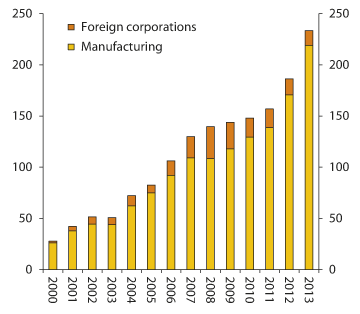
Figure 2.2 Outstanding bonds on Oslo Børs and Oslo ABM. Bonds issued by foreign corporations and Norwegian manufacturing corporations, etc. NOK billion
Source Oslo Børs.
The financial sector funds economic activity by providing loans and equity, and it channels and manages large sums on behalf of its customers. Norwegian banks manage approximately NOK 1,900 billion in deposits and borrowings from customers. Life insurers manage approximately NOK 1,000 billion set aside for the funding of future pension benefits.
The financial system comprises financial institutions and other market participants, marketplaces and transaction infrastructure. It is important for all economies that the financial transactions resulting from economic interaction can be executed swiftly, securely and at low cost. One characteristic of the Norwegian financial market is the development of an efficient and well-functioning financial infrastructure to handle such transactions. The abolition of paper-based services and the use of electronic solutions have delivered important efficiency gains. The Financial Markets Report 2012 devoted a separate chapter to the financial infrastructure in Norway.
Financial market undertakings hold licenses based on what type of activities they are engaged in. Credit institutions, i.e. banks, credit undertakings and finance companies, are by far the largest group in terms of total assets, followed by life insurance companies in second place, cf. Figure 2.3 and Table 2.1. The figure illustrates developments in the relationship between the total assets of credit institutions and insurance companies, with the exception of pension funds, and mainland Norway GDP. The financial sector has grown as a portion of the overall Norwegian economy over the period from 1970 to 2013. Growth in the total assets of credit institutions, insurance companies and other financial institutions has outpaced GDP growth, apart from in the early 1990s and for the last couple of years. At yearend 2013, the total assets of these institutions were equivalent to 320 pct. of GDP. The Norwegian financial sector is not particularly large as a portion of GDP in international terms.
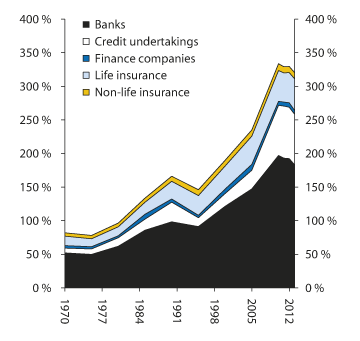
Figure 2.3 Basic value of gross product. Finance and insurance activities as a portion of total economic activity and mainland Norway economic activity. Percent
Basic value is the value accruing to the producer of a product after the payment of value added tax and other product taxes and the receipt of any public product subsidies.
Source Statistics Norway.
Table 2.1 The structure of the Norwegian financial market (incl. foreign branches). Number of institutions and total assets (NOK billion) in different sectors. Percent of total assets in different sectors and in total (market share). As at 31 December 2013
Credit institutions | Securities funds | Non-life insurance | Life insurance | Total | |
|---|---|---|---|---|---|
Total assets | 5,355 | 663 | 210 | 1,090 | 7,318 |
Percent of total assets | |||||
DNB | 40 | 17 | 1 | 27 | 35 |
SpareBank1/Samarbeidende Sparebanker | 15 | 5 | 7 | 3 | 12 |
Nordea | 11 | 10 | 0 | 7 | 10 |
KLP | 0.5 | 15 | 2 | 31 | 6 |
Storebrand | 1 | 12 | 1 | 23 | 5 |
Eika group | 5 | 1 | 2 | 0 | 4 |
Gjensidige | 0.5 | 0 | 27 | 1 | 1 |
Total financial groups/alliances | 73 | 60 | 40 | 92 | 74 |
Other companies | 27 | 40 | 60 | 8 | 26 |
Overall market | 100 | 100 | 100 | 100 | 100 |
of which foreign branches | 14 | 29 | 0.3 | 11 | |
of which foreign-owned subsidiaries | 14 | 0.4 | 1 | 10 |
Total assets of branches and subsidiaries abroad are included for credit institutions.
Source Finanstilsynet and the Norwegian Fund and Asset Management Association.
At yearend 2013, the Norwegian credit market comprised 220 credit institutions. These institutions included 124 Norwegian1 banks and 54 credit undertakings (mortgage companies and finance companies). In addition, there were 42 branches of foreign credit institutions in Norway. Mortgage companies primarily provide mortgages to fund housing purchases and commercial activities, whilst finance companies primarily engage in financial leasing, car purchase financing, card-based lending and other consumer credit. These credit institutions held total assets of approximately NOK 5,355 billion.
There are 30 securities fund management companies in the Norwegian market. These include both institutions holding Norwegian licenses and foreign branches operating in Norway. These hold total assets of about NOK 663 billion. This is approximately NOK 100 billion more than in 2012.
114 undertakings are engaged in insurance activities in the Norwegian market (institutions holding Norwegian licenses and foreign branches operating in Norway). 95 of these are engaged in non-life insurance. Foreign branches account for a relatively large proportion of non-life insurance providers. Foreign branches accounted for approximately 29 pct. of total non-life insurance activity, measured by total assets.
At yearend 2013, there were 19 life insurance companies in the Norwegian market; 2 less than the previous year. These 19 companies include 10 Norwegian-owned and 2 foreign-owned companies, with the remainder being small branches of foreign undertakings. Life insurance companies held total assets of approximately NOK 1,090 billion. There are 84 pension funds in the Norwegian market. These hold total assets of approximately NOK 220 billion.
Besides, the financial sector features marketplaces that help to channel capital into various commercial activities. One company in Norway is licensed to operate as a securities exchange. In 2013, the Oslo Børs traded equity instruments valued at more than NOK 800 billion. Equity issues, i.e. the raising of new equity, accounted for approximately NOK 18 billion, cf. Figure 2.4. In addition, new bond loans amounted to about NOK 160 billion.
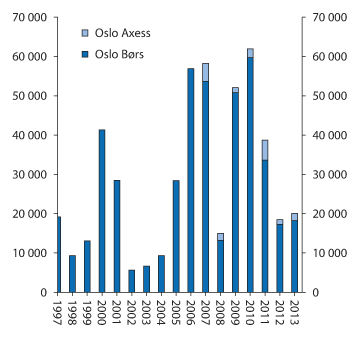
Figure 2.4 Equity issues. Oslo Børs. NOK million.
Source Oslo Børs.
Oslo Børs largely mirrors the Norwegian economy. Norway is, inter alia, one of the world’s largest fish and seafood exporters. This is reflected on Oslo Børs, which is the world’s largest financial marketplace for the seafood sector. Norway is the world’s third largest gas exporter and fifth largest oil exporter. Oslo Børs has the second largest number of listed energy companies in Europe and the second largest number of listed oil services companies in the world. Companies included in the energy index; OSLO Energy Index, account for about half of the market value of the Oslo Børs and Oslo Axess. Norway is also a shipping nation. This is reflected in Oslo Børs being the exchange in Europe with the largest number of listed shipping companies. Worldwide, only the New York Stock Exchange has a larger number.
Overall, the financial industry makes a major contribution to value added in the Norwegian economy. Figure 2.5 illustrates developments in the gross product of the finance and insurance industries as a portion of the gross product of all industries, and of mainland Norway, respectively. Gross product is a representation of value added, and is defined as production less inputs.
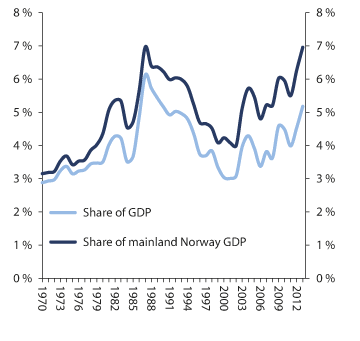
Figure 2.5 Basic value of gross product. Finance and insurance activities as a portion of all industries and of mainland Norway. Percent
Source Statistics Norway.
The figure shows that gross product in the financial industry, as a portion of gross product in the Norwegian economy, grew significantly following the deregulation of the financial industry in the 1970s and 1980s, until the banking crisis in the late 1980s and early 1990s. After a decline in the wake of the banking crisis, relative gross product has rebounded since the turn of the millennium.
Value added (factor income) in a sector accrues to the owners of the factors of production, in the form of wage income for the owners of manpower, profits for the owners of real assets, land rent or resource rent for the owners of land and other resources, or taxes for the public sector.
In 2013, bank and insurance employment amounted to about 54,000 man-years, with wage costs of approximately NOK 45 billion. Credit institutions, insurance companies and pension funds registered total operating profits of NOK 89 billion. Wage costs may be considered the remuneration of manpower, whilst profits may be considered the remuneration of capital and natural resource inputs. Figure 2.6 illustrates operating profits as a portion of factor income in selected industries. The figure shows that a relatively large part of financial industry factor income accrues to the owners of capital, although it should be recalled that natural resources, etc., shall also be remunerated from operating profits. The figure reflects, inter alia, the capital intensiveness of the financial industry, which results in wages accounting for a relatively small portion of factor income compared to other industries.
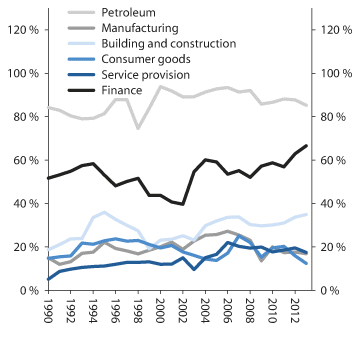
Figure 2.6 Operating profits as a portion of factor income in selected industries
Source Statistics Norway.
2.2.2 Government regulation
2.2.2.1 Safeguarding financial stability
The authorities seek to prevent solvency and liquidity crises in the financial system through statutory and regulatory requirements, as well as through the supervision of financial institutions and financial markets. In Norway, considerable weight has been attached to comprehensive and consistent regulation, involving, inter alia, identical regulation of the same type of risk, irrespective of where it is located, thus preventing risk from accumulating where it is subject to the least regulation. This principle has underpinned Norwegian financial markets regulation for many years. It is also a prerequisite for financial stability, and an important objective in itself, to have good consumer protection in the financial market.
Responsibility for the safeguarding of financial stability in Norway is shared between the Ministry of Finance, Norges Bank and Finanstilsynet. The Ministry of Finance has overarching responsibility for ensuring that the financial system functions well. Norges Bank and Finanstilsynet are charged with promoting the robustness and efficiency of the financial system, and therefore with monitoring financial institutions, securities markets and payment systems to identify stability threats. Moreover, Finanstilsynet supervises financial institutions and marketplaces. Norges Bank is the lender of last resort.
In 2006, so-called tripartite meetings were established between the Ministry of Finance, Norges Bank and Finanstilsynet. At these tripartite meetings, information is exchanged about, inter alia, Norwegian and international economic developments and the state of the financial markets. These meetings are held every six months, and more frequently when needed. Two such tripartite meetings were held in 2013, whilst one has been held thus far in 2014.
2.2.2.2 Direct and indirect taxes
The Government will use the tax system to fund communal goods, ensure social mobility, achieve more efficient resource utilisation and improve conditions for Norwegian businesses. The tax system influences labour supply, consumption, savings and investments. It is therefore important for the tax system to be designed on the basis that society’s resources shall be utilised in the best possible manner. These general considerations also apply to financial sector taxation.
Corporate taxation emphasises equal treatment of different investments, forms of funding and organisational structures, as well as symmetric treatment of income (gains) and expenses (losses). Financial institutions are in most respects subject to the same tax rules as other corporations. Interest income is taxed as ordinary income, whilst interest costs are fully deductible on the part of financial institutions. Profits are taxed at a fixed rate of 27 pct., as for other corporations. However, there are special rules on the loan loss provisions of banks and the fund assets of life insurance companies.
Personal taxation includes a number of instances of particularly favourable treatment of certain financial products. One example is the home investment savings scheme for people below the age of 34 years (BSU), which offers tax deductibility up to a specific limit for savings intended for housing purposes. Another example is pension savings. Employers are required, on certain conditions, to provide a retirement pension scheme for their employees; so-called mandatory occupational pension (OTP). Pension savings under such occupational pension schemes are treated more favourably than other savings. Under occupational pension schemes, contributions (premiums) are deductible on the part of the employer, although these are exempted from wage taxation on the part of the employee. The realised, current return on the pension assets is not taxed, and no wealth tax is levied on such assets. Payments from the scheme are taxable as pension income. The combination of mandatory occupational pension (OTP) and the favourable tax treatment has resulted in a large portion of the total assets of life insurers being linked to such occupational pension schemes. Private individuals may also save through tax-stimulated individual pension schemes (IPS).
It is especially in one respect that the tax rules applicable to the financial industry differ from the general tax rules. Financial services are, as a main rule, excluded from the value added tax system. Value added tax is a general tax on the domestic consumption of goods and services, the purpose of which is to raise revenues for the State. Value added tax is collected and transferred to the tax authorities by VATable businesses. The financial service exemption implies that users do not pay value added tax, but also that financial institutions cannot deduct the value added tax on goods and services purchased by themselves. The background to the exemption is that part of the value added of financial institutions originates from margin-based services, including interest rate margins. It is not possible to tax margins by way of an ordinary value added tax, and this is one of the reasons why one has chosen to make an exemption for financial services. Financial institutions pay some value added tax since they are unable to deduct input VAT, and because they have some turnover of VATable services. Rough estimates nonetheless indicate a shortfall of about NOK 8 billion compared to a situation in which all value added from financial services would be taxed at 25 pct. (except life insurance).
A number of countries levy special direct or indirect taxes on the financial industry. These are partly intended to raise revenues for government, partly to fund any future emergency measures through special reserves, and partly to supplement traditional financial markets regulation, for example by reducing the incentive to assume high risk. Norway has not introduced special direct or indirect taxes for the financial industry, with the exception of the levy payable to the Norwegian Banks’ Guarantee Fund. In the NOU 2011:1 Green Paper; Better Prepared for Financial Crises, the Norwegian Financial Crisis Commission proposed, inter alia, that the authorities should examine the scope for levying a financial stability fee on the financial industry to correct for the financial advantage enjoyed by that industry through the expectation of a government bailout in the event of crisis, and a so-called financial activities tax on profits and wage payments to correct for the non-payment of value added tax by the financial sector.
Some countries have introduced taxes to partly correct for the exemption of financial services from value added tax. France introduced a special tax on wages in exempted sectors, including the financial sector, in 1968. Denmark has since 1990 levied a special tax on wage costs in a number of sectors exempted from value added tax, including the financial sector. The rate is higher for the financial sector than for other sectors. In 2014, it was 11.4 pct. The rate is to be increased every year until reaching 15.3 pct. in 2021. Such extra taxation of wage costs can in principle capture the value added accruing to manpower, whilst the value added extracted in the form of profits is not captured. In 2012, Iceland introduced a financial activities tax for financial institutions, with the exception of pension funds, which encompasses both wage costs and large profits. In addition to ordinary tax, remuneration for employees is taxed at 5.5 pct., whilst profits in excess of ISK 1 billion are taxed at 6 pct.
Non-life insurance is taxed in many countries. Australia and New Zealand, for example, have ordinary value added tax subject to certain special rules for non-life insurance. Most EU countries levy special taxes on insurance premiums.
Several countries have introduced so-called financial stability fees or bank levies in the wake of the financial crisis. These fees and levies can differ very considerably from country to country in their particulars, but are generally comparable to the levy paid by banks in Norway to the Norwegian Banks’ Guarantee Fund. Such fees and levies often use all or part of the total assets of financial institutions as the tax base. Solutions differ with regard to whether the proceeds are channelled to the treasury or into reserves intended to secure deposits and prevent or pay for future crises in the banking sector.
Sweden, Finland and Iceland have all introduced fees or levies on balance sheet items. In Sweden, moreover, it has been announced that banks shall contribute to the funding of government foreign exchange reserve accumulation, since the international funding of banks imposes a risk on the economy in the form of potential foreign exchange reserve depletion. In Norway, part of the levy payable to the Guarantee Fund is calculated on the basis of balance sheet items, and from 1 January 2013 banks have to pay the levy each year. They previously only paid the levy when the Guarantee Fund was underfunded. The Banking Law Commission is currently looking into a revision of the legislation governing our overall deposit guarantee system in view of, inter alia, relevant EU regulations; see section 3.2.5 for further details.
2.3 The macroeconomic situation
Five years after the outbreak of the international financial crisis, some countries still have lower economic activity (GDP) than before the crisis. Global economic growth nonetheless rebounded somewhat last autumn, driven, in particular, by developments in traditional industrialised countries. The US would appear to be experiencing a robust revival, and the Euro zone countries are on their way out of the longest period of negative growth in the history of the currency union. Important measures adopted by European authorities, not least by the European Central Bank, have reduced the risk of another setback.
The last year has seen financial turbulence in several emerging economies. Prospects for higher returns on financial investments in the US and other traditional industrialised countries caused capital outflows from a number of large emerging economies and depreciation of their currencies. Many of these countries have little freedom of action in economic policy. China has not suffered capital outflows like other emerging economies, but Chinese currency has depreciated somewhat and economic growth is lower than before the financial crisis. A setback in China and other emerging economies may have serious implications for the world economy and trigger an oil price reduction.
The Norwegian economy has been performing well for a long time. Employment is high and unemployment is low. Norwegian export goods have experienced steep price growth since the turn of the millennium, whilst some import goods have registered low prices. A high oil price and a large increase in investments on the Norwegian continental shelf have resulted in high capacity utilisation and low unemployment, whilst having at the same time contributed to a bifurcation of the Norwegian economy. Businesses that make large deliveries to the petroleum industry in Norway and abroad have grown, whilst the situation for businesses competing in more traditional export markets is challenging.
A decade of high oil prices and favourable developments in the terms of trade has resulted in wage increases in Norway outpacing those in other countries for a number of years. Many Norwegian businesses have been sheltered by high prices on their products, but developments have not been equally favourable for all industries. Many Norwegian businesses are vulnerable to price reduction or Norwegian kroner appreciation. 2013 registered significant Norwegian kroner depreciation. Norwegian kroner depreciated by more than 10 pct. over the course of 2013, as measured by the trade-weighted index. The Norwegian kroner depreciation has somewhat improved cost competitiveness in Norway, thus contributing to continued high production and employment in the Norwegian economy.
Housing prices have been growing for a number of years; see Box 2.2 below, whilst there has been a large increase in household debt. High debts and predominantly variable interest rate loans mean that even minor interest rate increases will swiftly result in a reduction in the purchasing power of households.
It is likely that the high level of household debt, together with the high cost level, served to subdue the increase in activity in the mainland economy last year. Although household income growth held up, household consumption growth was clearly weaker in 2013 than in 2012. Increased household awareness of the risks associated with high debts may be a contributing factor. The strong production growth in industries supplying the petroleum sector levelled off somewhat last year. Growth in more traditional export industries still remains low.
The interest rate path in the most recent monetary policy report from Norges Bank in March 2014 assumes that the key policy rate will remain at the current level until the summer of 2015, and thereafter be increased gradually. The Ministry of Finance expected, in its supplementary proposition for 2014, mainland Norway GDP growth of 2.5 percent this year. The levelling off in the Norwegian economy throughout 2013 and thus far in 2014 indicates that mainland Norway GDP growth may be somewhat lower than this. The Ministry of Finance will submit new estimates in the revised National Budget in May.
2.4 Credit institutions
2.4.1 Risk factors
Banking involves, inter alia, the funding of long-term, illiquid lending and other long-term, illiquid assets by liquid deposits. Differences in the maturity structure of assets and liabilities give rise to a risk that a bank will be unable to refinance assets when needed. The risk that a bank is unable to meet liabilities upon maturity despite being solvent, i.e. the value of its assets exceeding the value of its liabilities, is called liquidity risk.
Banks that fund lending by liquid deposits are faced with a liquidity risk, which comes down to the risk that an unusually large number of depositors may request payment of their deposited amounts at the same time. As long as depositors act independently of each other, one can keep fairly good track of such risk and hold sufficient liquid assets to handle said risk. Disquiet amongst depositors may be difficult to handle for one single bank, but the deposit guarantee scheme serves to reduce the risk that disquiet arises.
Borrowing in the capital market has become an important part of the funding of Norwegian banks and other credit institutions over the last few decades. Market funding means that banks can manage their liquidity risk in a manner not possible with deposits. However, the financial crisis demonstrated that the liquidity risk of a bank may increase swiftly and steeply if these markets become less liquid and the said bank has assumed that new funding will always be available in the market on short notice.
The percentage of short-term market funding on the part of banks and mortgage companies has declined in recent years, cf. Figure 2.7. At the same time, bond loans with a maturity in excess of one year, including covered bonds, have increased significantly as a portion of total funding and now account for about 30 pct. Covered bonds account for the majority hereof. Besides, the maturity of covered bonds and other bond loans has also increased steadily over the years since the financial crisis. Average maturity is currently 6–7 years. These figures suggest that banks are less vulnerable to a decline in access to new market funding. Said figures also suggest that NIBOR and other short-term interest rates are now of less importance to the overall funding costs of banks, cf. the discussion in section 2.8.2.
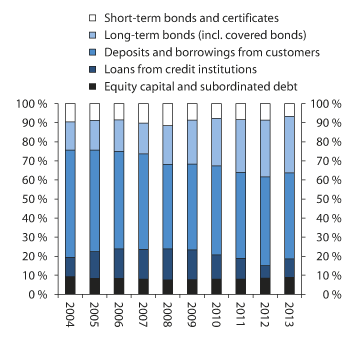
Figure 2.7 Composition of the funding of banks and mortgage companies. Percent of total assets. Percent
Source Finanstilsynet.
One of the reasons why covered bonds have emerged as one the most important sources of funding is that banks have profited from selling off well-secured residential mortgages to mortgage companies that can issue covered bonds, whilst retaining riskier assets on their own balance sheets. The scope for issuing covered bonds offers more flexibility and access to new funding markets, but this development implies that there will in a crisis be reduced access to secure assets that these institutions can collateralise to secure funding. This may, when taken in isolation, result in less stable access to new market funding.
Banks and mortgage companies issued bond debt in the approximate amount of NOK 440 billion in 2013. This is on a par with the average for the last few years. Covered bonds account for a majority of issuances, most of which are in foreign currency. Foreign currency debt funds lending and other assets denominated in Norwegian kroner, thus giving rise to a not insignificant foreign exchange risk on the part of these institutions. Institutions hedge such risk through foreign exchange swaps in the derivatives market. The need of banks for using the derivatives market to hedge their foreign exchange risk also represents a potential risk that may become evident in case of derivatives market turbulence.
It is important for institutions to manage their liquidity risk well. New requirements to be introduced in accordance with new EU regulations will entail quantitative liquidity risk limitations; see the discussion in Chapter 3. Whilst the liquidity coverage requirement (LCR) shall ensure that institutions have sufficient liquid assets to handle periods of funding market failure, the net stable funding requirement (NSFR) shall ensure that funding is sufficiently stable relative to the maturity of assets. Final formulation of the requirements has yet to be completed, but the reporting suggests that the major Norwegian banks are reasonably well placed for LCR compliance. Small banks generally have lower liquidity coverage than large ones.
Credit institutions are primarily engaged in lending, and hence credit risk is normally the most important risk factor for such institutions. Credit risk is closely linked with the ability and willingness of Norwegian households and businesses to pay interest and instalments, and with developments in the value of homes and other mortgaged property.
In recent years, Norwegian credit institutions have, with a few exceptions, being offering credit in a growing domestic market. The credit indicators C2 and C3 are broad measures of the gross debt owed by the public – including, inter alia, municipal administrations, non-financial corporations and households – to Norwegian sources of credit and all sources of credit in total, respectively. Whilst twelve-month growth in household credit has remained stable, at just over 10 pct. until the financial crisis and about 7 pct. for the last few years, growth in credit to non-financial corporations has varied by much more; see Figure 2.8. Total growth in credit to corporations has increased quite steadily for the last couple of years, but a change was registered in late 2013; see the figure. A comparison of the C2 and C3 data for corporations shows that the recent reduction in credit growth reflects, in particular, a reduction in the growth of credit from foreign sources.
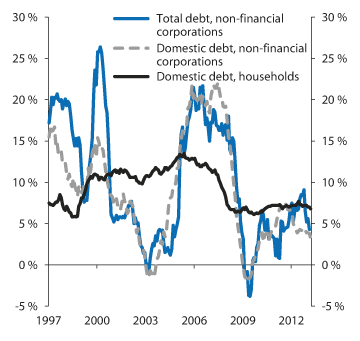
Figure 2.8 Twelve-month growth in domestic credit (C2) and total credit (C3) for households and non-financial corporations, respectively. Percent
Source Statistics Norway.
The debt burden and the interest burden are useful ratios for assessing the ability of households to service debts. The debt burden is debt as a percentage of disposable income, whilst the interest burden is interest expenditure as a percentage of disposable income. Debt growth has outpaced income growth for several years, thus implying that the debt burden has increased. The debt burden is currently about 200 pct.; see Figure 2.9. It is still increasing, but at a lower rate than before the financial crisis. The interest burden is relatively low, at 6 pct., but is sensitive to interest rate changes.
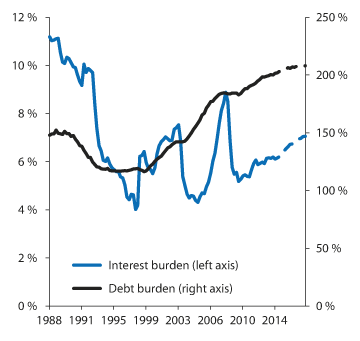
Figure 2.9 Household debt burden (right axis) and interest burden (left axis). Percent
Interest burden is interest expenditure after tax as a percentage of disposable income. Debt burden is gross debt as a percentage of disposable income.
Source Statistics Norway and the Ministry of Finance.
There are significant variations behind the average interest burden and debt burden. There is a risk that many households may find it difficult to cope with a major interest rate increase. Calculations from Norges Bank and Finanstilsynet show that many households would have to devote a large portion of their income to debt servicing in the event of a major interest rate increase. Norges Bank has, for example, been calculating the impact of an interest rate increase and a housing price decline on the number of households that are especially vulnerable to residential mortgage default, i.e. households with high debts, net debts that exceed the value of their homes, and a buffer of less than one month’s income after the payment of interest costs and necessary consumption. This group represented 2.4 pct. of all households in 2011. If the residential mortgage interest rate increases by 3 percentage points and housing prices decline by 30 pct., then 7 pct. of households will belong to this vulnerable group, based on the figures as per yearend 2011.2 Finanstilsynet has calculated, based on 2013 figures, how many households would have an interest burden in excess of 20 pct. if the lending rate had been higher. If the rate had been 2 percentage points higher in 2013, 19 pct. of households would have been saddled with an interest burden in excess of 20 pct. In fact, 8 pct. of households had an interest burden in excess of 20 pct. in 2013. If the lending rate had been 5 percentage points higher, more than 30 pct. of households would have been left with an interest burden in excess of 20 pct., which group of households would have accounted for close to half of all household debt.3 The growth in the debt burden means that the interest burden is now significantly higher for a given interest rate level than was the case in 1988.
More than half of credit institution lending is in the form of loans to households, of which about 90 pct. are residential mortgages. Consequently, conditions in the housing market have a major impact on loan demand. In recent years, demand for residential mortgages has increased steeply, whilst credit institutions have experienced good access to funding at a low interest rate. The fact that households have enjoyed good access to loans at a low interest rate may have fuelled the housing price increase, which has then increased the need and demand for loans. One may therefore say that supply has contributed to increasing demand. Correspondingly, one might envisage that a reduction in loan supply might reduce housing price growth, and eventually also reduce demand.
In 2013, the housing price increase came to a halt, cf. Box 2.2. If housing prices stabilise, it may result in debt growth gradually falling back to a more sustainable level. However, loan demand developments may be completely different. If housing prices fall unexpectedly or the interest rate increases more swiftly than expected, many households may experience an imbalance between assets and liabilities or between income and loan expenditure. Such financial imbalances on the part of households may result in credit institutions incurring higher losses on household loans. History shows that household imbalances may have a significant negative impact on the economy, even when residential mortgage losses are relatively low. This is because many households make entirely rational decisions to restore the balance by making repayments on residential mortgage and cutting back on other expenses, thus reducing overall demand in the economy. Higher savings help to restore the financial balance of individual households, but the outcome may be an increase in financial imbalances on the part of households as a group, for example through a further housing price reduction. It may also be rational for a bank to act in a manner that may deepen a recession. It may for example be rational to tighten lending practices vis-à-vis both businesses and households when the economy is showing signs of recession. However, if many banks do so simultaneously, the recession will happen more quickly and become deeper. Consequently, banks that are able to maintain a fairly stable lending practice into a recession may help stabilising the economy.
Textbox 2.2 Housing market developments
High real wage growth and low real interest rates have, together with a large population increase and, at times, good access to credit, resulted in steep housing price increases over several years. The increase turned into a reduction last year, and at yearend 2013 the price level was somewhat lower than at the beginning of the year. The average price level in 2013 was, nonetheless, 4.6 pct. higher than in 2012. Housing prices were 2.4 pct. higher in 2013 than in 2012 when corrected for retail price growth. The price level is very high, both historically and compared to other countries, cf. Figure 2.10A. Annual real growth in Norwegian housing prices over the period 2010–2012 averaged close to 7 pct.
Housing price growth has been significantly lower when deflated by developments in disposable income and average annual wages, but the housing price level is also historically high when thus measured; cf. Figure 2.10B.
Price developments for the main cities are showing large regional differences. Tromsø has for quite some time been registering the highest twelve-month growth, cf. Figure 2.10C. In February, housing prices in Tromsø were 6.7 percent higher than in the same month last year. Housing prices in Oslo declined by 3.3 pct. over the same period. Kristiansand registered the steepest reduction, with a decline of 6.4 pct.
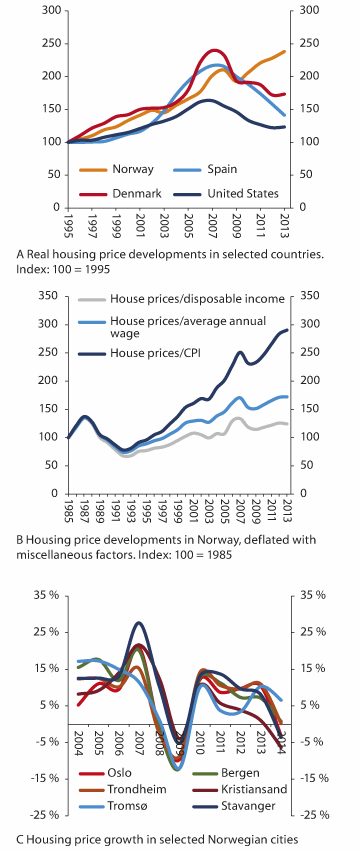
Figure 2.10 Real housing price developments in selected countries (A), housing price developments in Norway, deflated by miscellaneous factors (B) and housing price growth in selected Norwegian cities (C)
Source Federal Reserve Bank of Dallas, EFF, Finn, Eiendomsverdi, Macrobond, Statistics Norway, Norwegian Technical Calculation Committee for Wage Settlements (TBU) and the Ministry of Finance.
Moreover, the lending practices of banks during an upturn have an impact of stability in the economy. The risk of mounting financial imbalances on the part of households is especially pronounced during a long period of strong economic expansion, or when interest rates remain low for a long time, thus implying high loan demand for an extended period. If the residential mortgage practices of banks are too lenient during such lengthy periods of high loan demand, large imbalances may arise.
Every year, Finanstilsynet surveys the residential mortgage practices of banks. The most recent survey was conducted in August and September 20134 and shows, inter alia, that 23 pct. of new residential mortgages had a loan-to-value ratio, i.e. loan as a percentage of the value of the home, in excess of 85 pct. In comparison, 27 pct. of the loans in the survey from 2012 had a loan-to-value ratio in excess of 85 pct. The proportion of loans with a loan-to-value ratio in excess of 100 pct. declined from 11 to 8 pct. Unsurprisingly, young borrowers are especially likely to apply for loans that a large relative to the value of their home. Moreover, the residential mortgage survey for 2013 shows a significant reduction in both the number of interest-only loans and the duration of interest-only periods. In the 2013 survey, 12 pct. of residential mortgages were interest-only loans, as compared to 25 pct. a couple of years ago. The average interest-only period has been reduced by about one year over the same period of time. The residential mortgage survey is, inter alia, used in the follow-up of Finanstilsynet’s guidelines on prudent lending practices for residential mortgages; see the discussion in Chapter 3.
Lending to non-financial corporations accounts for about 40 pct. of overall lending by Norwegian credit institutions. A large portion of lending to corporations is in the form of loans to corporations engaged in shipping or commercial property, which industries are especially sensitive to cyclical developments.
Bank loans constitute the main source of funding for Norwegian corporations, but large corporations, in particular, have in recent years raised more of their funding in the bond and certificate market.
Levelling off in the Norwegian economy and lower investment activity on the Norwegian continental shelf are resulting in a weaker earnings outlook for Norwegian corporations, cf. section 2.4 over. Levelling off in the Norwegian economy and uncertainty about international cyclical developments may have an impact on supply and demand in major parts of the market for loans to corporations. The debt-servicing capacity of listed corporations has declined somewhat over the last year, cf. Figure 2.11.
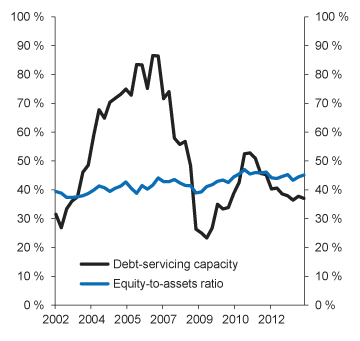
Figure 2.11 Equity-to-assets ratio and debt-servicing capacity of listed corporations. Percent
Source Norges Bank.
2.4.2 Solvency and earnings
The capacity of a bank to absorb loss without depositors and other ordinary creditors incurring any loss is highly dependent on the quantity and quality of the total assets of such bank. The new capital adequacy rules adopted in 2013 stipulate that common equity tier 1 (CET1) capital shall constitute no less than 4.5 pct. of risk-weighted assets. CET1 capital is predominantly equity, and is the type of capital offering the highest capacity to absorb loss. In addition to the minimum requirements, institutions shall have a CET1 capital buffer of no less than 4.5 pct. of risk-weighted assets, thus implying that the sum total of the minimum requirement and the buffer requirement is 9 pct. The new buffer requirements will be gradually increased until 1 July 2016. By that date the total CET1 capital requirement will be 11 pct., including a counter-cyclical capital buffer requirement of 1 pct., for banks that are not systemically important, whilst the overall requirement will be 13 pct. for systemically important banks.5
All Norwegian banks met the minimum requirement and buffer requirement applicable at yearend 2013. When weighted by bank size, the average CET1 capital ratio was 12.2 pct. at yearend 2013, which is an increase of 1.1 percentage points from the previous year, cf. Figure 2.12.
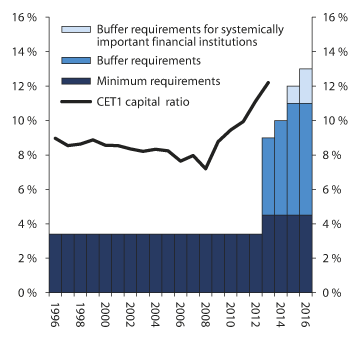
Figure 2.12 CET1 capital as a percentage of risk-weighted assets (CET1 capital ratio) for Norwegian banks and banking groups, as well as CET1 capital ratio minimum requirements and buffer requirements. Percent
Source Finanstilsynet and the Ministry of Finance.
It is evident from the figure that Norwegian banks have improved their solvency significantly in recent years. For banks as a whole, the CET1 capital ratio has increased steadily by a total of 5 percentage points since 2008. However, if solvency improvement is measured differently, by CET1 capital as a portion of non-risk-weighted total assets, the increase has not been equally large. For banks as a whole, this measure of solvency has increased by about 1.5 percentage points over this five-year period, to a level of 6.5 pct. at yearend 2013. This is not high in a historical perspective. The difference between the CET1 capital ratio and the non-risk-weighted measure has been increasing for a number of years, and has never been higher than at yearend 2013. The increase in such difference may indicate higher growth in lending that is accorded less weight when calculating risk-weighted assets for capital requirements purposes, for example lending for residential purposes.
Differences between various measures of solvency are also large for many foreign banks. Figure 2.13 shows the robustness of the largest financial groups in the Nordic region based on three different measures of solvency. The difference between the CET1 capital ratio and CET1 capital as a portion of non-risk-weighted total assets is not large for the Norwegian bank DNB ASA when compared to the other groups.
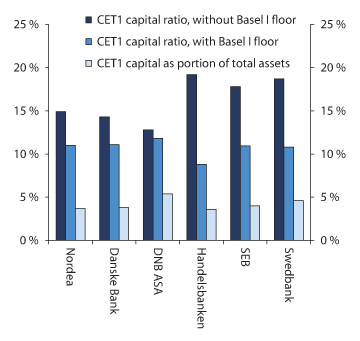
Figure 2.13 CET1 capital ratio with and without Basel I floor and CET1 capital as a portion of total assets (TA) at yearend 2013. Nordic financial groups. Percent
Source Finanstilsynet.
Large financial institutions, including all large Nordic financial groups, often calculate risk weights using internal models (the so-called IRB approach). These models generally result in lower capital requirements for banks than would have applied if they had instead used the so-called standardised approach, under which the risk weights are stipulated in regulations, and this is likely to be part of the motivation for adopting the IRB approach. In order to prevent capital requirements from becoming very low, a transitional arrangement implies that institutions using internal models to calculate capital requirements need to keep above a certain limit as to the minimum risk weight they can attribute to their assets. This is referred to as the Basel I floor, since the lower limit is defined by reference to the former Basel I rules.
If one calculates the CET1 capital ratios of Nordic financial groups on the basis of their own models only, i.e. without the Basel I floor, the difference between the risk-weighted measure and the non-risk-weighted measure of solvency becomes very large as far as many banks are concerned, cf. Figure 2.13. The Swedish bank Handelsbanken, for example, looks very robust when considering that its CET1 capital ratio is 18 pct., but the CET1 capital of the bank represents no more than 4 pct. of its total assets. DNB ASA, on the other hand, may seem the least robust of the Nordic groups, since its CET1 capital ratio without the Basel I floor is the lowest in the sample, whilst DNB ASA has the highest CET1 capital relative to total assets. This topic is also discussed in Chapter 3.
Over the last five years, the CET1 capital ratios of the six largest banking groups in Norway have primarily been increased through retained profits and equity issues; cf. Figure 2.14. Some of the increase is also caused by a reduction in risk-weighted assets relative to CET1 capital, largely as the result of a reduction in average risk weights.
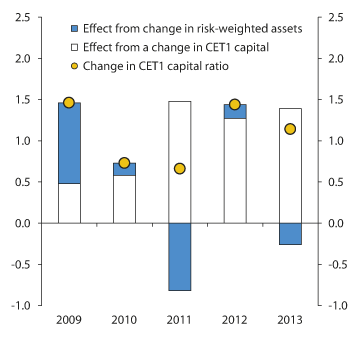
Figure 2.14 CET1 capital ratio changes (decomposed). Percentage points. Weighted average of the six largest banking groups. 2009–2013.
Source Norges Bank.
Norwegian banks registered total profits before tax in excess of NOK 45 billion in 2013; about NOK 8 billion more than the previous year. The improvement in earnings is primarily caused by an increase in net interest income, which is the main source of income for banks. There was a particular increase in the net interest income of banks and mortgage companies from residential mortgages in 2013.
Since banks are selling off lending portfolios to mortgage companies on a large scale, there has been a major increase in loans held by mortgage companies. All in all, about 56 pct. of all Norwegian residential mortgages are now held in residential mortgage companies that issue covered bonds.
In aggregate, the mortgage companies, excluding Eksportfinans ASA, registered significantly higher earnings in 2013 than the previous year, primarily because of higher net interest income. Profits before tax increased by about NOK 3.5 billion, to NOK 7.3 billion. Most mortgage companies that issue covered bonds are wholly owned by a bank, thus implying that their earnings are included in the earnings of the banks. These mortgage companies increased their CET1 capital ratios from 12.7 pct. to 13.1 pct. in 2013. The remaining mortgage companies that issue covered bonds, which are partially owned by several banks, had a CET1 capital ratio of 10.6 pct. at yearend 2013, which is the same as the previous year.
Finance companies registered profits before tax of about NOK 2.6 billion in 2013. This is somewhat higher than in 2012, and the earnings improvement has to do with an increase in net interest income.
Future developments are subject to uncertainty, and high household debts represent a risk of imbalances. Banks and other credit institutions are now better prepared for turbulence than a few years ago. They have strengthened their solvency, and they have a less risky funding structure. It is important for the institutions to continue to strengthen their solvency and reduce their liquidity risk. Conditions are favourable for this now that earnings are good and markets are well-functioning.
2.5 Insurance and pensions
2.5.1 Risk factors
Life insurers promise insured persons a benefit when a specific event occurs, for example when the insured person becomes disabled or reaches the age at which he or she qualifies for retirement pension. The monetary value of these promises constitutes the most important liabilities of life insurers.
The insurance risk of life insurers is largely related to whether more people become disabled, or whether the insured persons live longer than expected on average. Moreover, such risk is related to what type of insurance customers have. With regard to defined-benefit pensions, as opposed to defined-contribution pensions, insurers have for example often undertaken to provide a life-long retirement pension. If customers live longer than assumed when premiums were paid, insurance companies have to cover the shortfall.
Life expectancy is increasing in Norway. The life expectancy assumptions (the mortality basis) applied in recent years; the so-called K2005 basis for group pension schemes, do not take changes in the life expectancy of insured persons into account. Finanstilsynet therefore adopted a new minimum mortality basis requirement one year ago; see the discussion in Chapter 3 and in the Financial Markets Report 2012. The new minimum requirement is intended to ensure that life insurers allocate sufficient capital to accommodate the higher life expectancy.
Transition to the new mortality basis will require insurance companies to increase retirement pension premiums in group pension schemes. The financial allocations for previously accrued retirement pensions will also have to be increased. Companies may use any excess returns from the management of customer funds (returns on the group portfolio in excess of the rate guaranteed to customers) to fund up to 80 pct. of this increase in allocations (reserve building); see section 3.3.4 for further details. Life insurance companies allocated about NOK 8 billion of their excess returns to reserve building in 2013. The remaining reserve building needs are about NOK 19 billion.
The Insurance Activities Act stipulates that customers with group pension products and defined benefits shall each year make prepayment for the management of the pension assets. Insurance companies carry a market risk, i.e. they may incur a loss when the market prices of assets change. This is because companies have offered customers a guaranteed rate, i.e. guaranteed them a return on their funds. It is important for companies to charge for this guaranteed rate, and for them to use the income from this to accumulate adequate net asset buffers for those years when customer portfolio returns are lower than the guaranteed rate.
Companies cannot charge a guaranteed rate premium for paid-up policies or individual insurance policies established before 2008. Instead, they earn their income by the company and the customer sharing any excess returns from asset management in those years when such returns exceed the guaranteed rate. This pricing based on the sharing of any excess returns means that life insurers are especially vulnerable if they have accumulated inadequate net asset buffers before a period of low returns on customer assets.
Market yields on low-risk fixed-income securities have declined in recent years. Market yields on government bonds are generally below the average guaranteed rate, despite interest rates having increased significantly in 2013, cf. Figure 2.15. A persistently low interest rate level will make it challenging for companies to ensure a sufficiently high return to match the guaranteed rate.
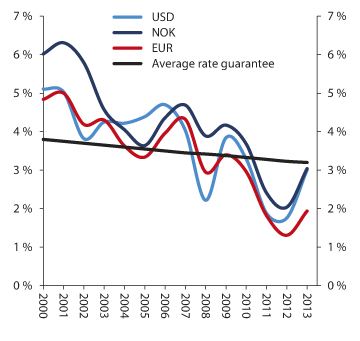
Figure 2.15 Developments in the average rate guaranteed by Norwegian life insurance companies and yields on 10-year government bonds in Norway (NOK), the US (USD) and the Euro zone (EUR).1 Percent
1 AAA-rated bonds.
Source Finanstilsynet.
The market risk of life insurance companies has been closely linked to developments for bonds and certificates. Whilst the equity portion of asset portfolios has declined, the fixed-income portion has increased, cf. Figure 2.16.
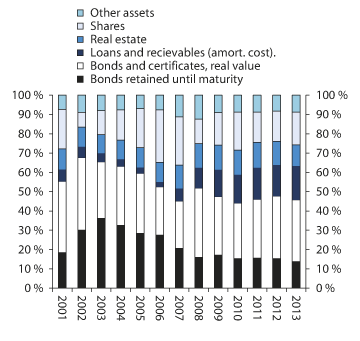
Figure 2.16 Life insurance company assets. Portion of total funding
Source Finanstilsynet.
2.5.2 Solvency and earnings
In 2013, life insurance companies earned profits before tax of NOK 6.9 billion. This represented a NOK 1.8 billion increase over profits in 2012. Value-adjusted profits before tax (taking account of unrealised capital gains) were NOK 16.4 billion in 2013.
The buffer capital expresses the ability of life insurance companies to absorb losses whilst maintaining compliance with the stipulated minimum capital requirements.6 The buffer capital of life insurance companies represented 6.1 pct. of total assets at yearend 2013, which is about 0.6 percentage points higher than in 2012, cf. Figure 2.17. This is primarily the result of an increase in the market price adjustment reserve, which reflects unrealised changes in the market value of group portfolio assets.
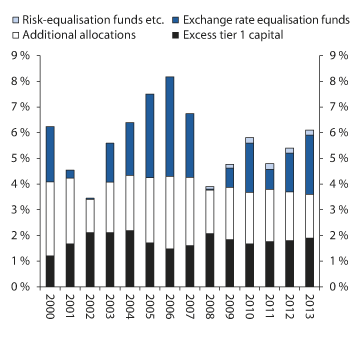
Figure 2.17 Buffer capital developments. Percent of total assets
Source Finanstilsynet.
The capital adequacy ratio of companies as a whole was 16.8 pct. at yearend 2013. This is an increase of 0.6 percentage points from 2012. The capital adequacy requirement applicable to life insurance companies is, like that applicable to credit institutions, 8 pct. of risk-weighted assets. All companies met this capital adequacy requirement.
Pension funds earned profits before tax of about NOK 2 billion in 2013.7 This is equivalent to about 1 pct. of their average total assets. A significant unrealised increase in asset values resulted in value-adjusted profits of NOK 14 billion in 2013.
The capital adequacy ratio of pension funds as a whole was 15.5 percent at yearend 2013, which is a decrease of about 1 percentage point from the previous year.
Life insurers are facing major challenges in relation to rising life expectancy and low interest rates. As the Ministry of Finance has emphasised in its financial markets reports for several years, it is very important for life insurers to ensure that risk and solvency are well matched, with a substantial margin of safety.
Non-life insurance companies earned profits before tax of NOK 6.8 billion in 2013,8 which is NOK 0.3 billion less than in 2012. Total insurance claim costs and other insurance-related operating costs for own account, measured as a percentage of premium income for own account, are referred to as the combined ratio. It expresses the profitability of the actual insurance operations. A combined ratio in excess of 100 pct. means that the company needs other income than premium income to break even; for example financial income. In 2013, the combined ratio of non-life insurance companies was 88 pct. This was 1.5 percentage points lower than the previous year; cf. Figure 2.18. Both the claims ratio, i.e. claims payments as a percentage of premium income, and the cost ratio, i.e. operating expenses as a percentage of premium income, declined.
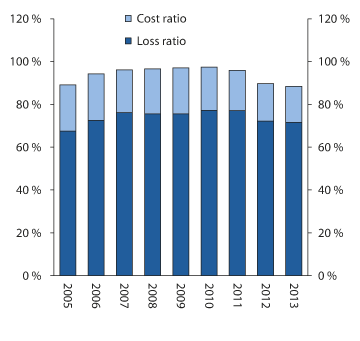
Figure 2.18 Developments in the cost and claims ratios of non-life insurance companies. Percent
Source Finanstilsynet.
Overall, the solvency situation of Norwegian non-life insurance companies was fairly good in 2013. The capital adequacy ratio of non-life insurance companies was 43.3 pct.
2.6 Investment firms
Investment firms that are not integrated into banks registered operating income of NOK 6.5 billion in 2013, approximately NOK 1 billion more than in the previous year. The income increase was primarily generated within corporate finance activities, which is a core area for these firms. Operating profits were about NOK 1.2 billion, which is NOK 617 million more than in 2012. Investment firms that are integrated into banks and branches of foreign investment firms registered a decline in operating income of 21 and 18 pct., respectively, from 2012 to 2013.
2.7 Operational risk in financial undertakings
Operational risk is the risk of loss as the result of incomplete or inadequate internal processes, systems failure or human error. Operational risk includes, inter alia, legal risk and reputational risk. The causes may, for example, be inadequate procedures, defective information and communications technology systems (ICT systems), regulatory violations, fire, negative publicity or lack of trust. Delimitation against other types of risk is not precise, and losses classified under credit risk or market risk may be caused or multiplied by operational failure, for example weaknesses in credit evaluation processes.
The Ministry of Finance promotes a systematic preventive effort to reduce the vulnerability of financial institutions and financial markets, as well as to ensure adequate preparedness for dealing with risk events. The Financial Infrastrukture Crisis Preparedness Comitee (BFI) was established to ensure the best possible coordination of financial infrastructure preparedness efforts. The Committee examines operational stability, risk and vulnerability in the financial infrastructure. In 2013, the Committee held three regular meetings and conducted one emergency preparedness exercise. Finanstilsynet is the secretariat of the BFI, and hence the activities of the Committee are also discussed in Chapter 6 on the activities of Finanstilsynet.
Banks’ access to a joint payment infrastructure means that customers of one bank can readily and cost-effectively perform transactions with customers of other banks. Systems stability in the Norwegian financial infrastructure is quite good, and losses as the result of misuse and fraud are small. The infrastructure is nonetheless vulnerable to technical failure and external threats. The Ministry of Finance discussed vulnerability in the financial infrastructure in Chapter 5 of the Financial Markets Report 2012. Figure 2.19 shows that systems availability in the financial infrastructure was somewhat better in 2013 than in previous years.9 The majority of the adverse events and errors that occur are related to online banking problems.
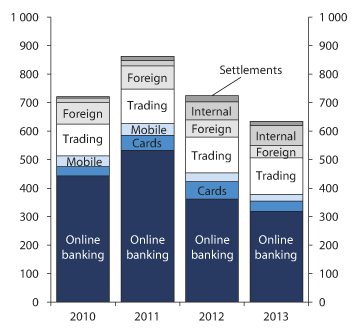
Figure 2.19 Impact-weighted adverse events and errors in Norwegian financial undertakings
The readings along the vertical axis represent a weighted and totalled assessment of the scale of the adverse impact of events within various services. The services are online banking (individuals and businesses), payment cards, mobile payments, stock trading, international payment, internal services, as well as clearing and settlement. The scale of the adverse impact is derived from the number of users affected, the duration of the event and a discretionary assessment of how serious the event was for users. The data in the figure can only be used to compare the scale of impacts across services and from year to year.
Source Finanstilsynet
An ever more relevant theme is the outsourcing by financial undertakings of ICT systems operations and development to other suppliers. Outsourcing of ICT activities can reduce costs, but may also make payment systems and other parts of the financial infrastructure more vulnerable to operational interruption. One may, for example, get reduced control over systems and more operational risk if a large part of ICT activities in the financial sector are outsourced, domestically or abroad. This may also increase the risk that unauthorised persons get access to (and steal) confidential financial information.
Finanstilsynet classifies ICT tasks as follows:
ICT operations that require those responsible for such operations to have the rights of access necessary to ensure effective implementation and to intervene if problems arise, for example at night. The implications of errors and undesired events can be severe.
Tasks that are linked to ICT operations, but do not directly form part of ongoing operations, are somewhat less sensitive. When such tasks are performed abroad, the output will typically be delivered to a coordination centre in Norway before being entered into the operating system. Such duties may be, for example, evaluation of new computer software, changes to existing computer software or pre-implementation testing of such changes. The coordination centre in Norway is responsible for quality assurance of the output received.
Separate ICT development tasks performed under a supply arrangement with the coordination centre in Norway are also less sensitive. It is common practice for the coordination centre in Norway to acquire and ensure control over the developed solution, as well as to conduct its own testing and other quality assurance, prior to such solution being entered into use.
There is a long tradition in Norway for the outsourcing of ICT tasks in the financial sector. Most ICT suppliers are independent, and often stock exchange-listed, businesses with owners in Norway and abroad.
Until about 2000, all Norwegian banks had their ICT operations in Norway. A major part of the ICT operations of Norwegian banks and branches have now been relocated abroad in the wake of, inter alia, foreign acquisitions of Norwegian banks and outsourcing by remaining Norwegian-owned banks. Much of the securities-related ICT activities are also performed abroad.
Apart from those ICT operations of Norwegian financial undertakings that are performed in Sweden and Denmark, it is, in particular, separate ICT development tasks that are performed abroad for Norwegian financial undertakings. All major consulting firms, which are important suppliers for Norwegian financial undertakings, have their own subsidiaries in low-cost countries, especially in India. Besides, major Indian providers have gained contracts in the Norwegian market. Tasks relating to ICT operations are also being performed abroad to an increasing extent. Developments are driven by, inter alia, the cost-reduction needs of financial undertakings. Undertakings may, moreover, harbour expectations that well-known international operators will contribute to high quality in service production.
When services are delivered from countries located a long way from Norway, the choice of communications solutions may have a major impact on the risk associated with such deliveries. The said deliveries may be vulnerable to communications interruptions, unless one has back-up solutions via independent channels. There have, for example, been serious interruptions to communications lines routed via cables on the seabed. Such cables constitute a key component of the global electronic infrastructure. Multiple independent communications solutions for each delivery need to be established as far as the delivery of key services in, inter alia, the financial sector is concerned. Whether or not this is possible depends on where in the world such deliveries are made from.
Finanstilsynet emphasises that the relocation of ICT tasks outside Norway generally requires sophisticated risk assessment and risk management on the part of each financial undertaking; see Finanstilsynet Circular 14/2010. This is an especially important consideration when relocating tasks to areas of high country risk, i.e. politically and/or economically unstable countries. Finanstilsynet has concluded that the ICT tasks performed in areas of high country risk are not critically important, and that interruptions to the delivery of the output in question will not threaten financial stability or otherwise represent any threat to the relevant financial undertakings in Norway. Thus far, the tasks performed from high-risk areas have been limited in scale and risk. However, this may change within a fairly short period of time, as it would appear that more activities are being relocated to such areas. This may not result in a material change in risk for any individual financial undertaking, but the increase in risk for the financial infrastructure as a whole may nonetheless be significant. It may also represent a threat to customers, in the form of an increased risk of unauthorised disclosure of personal data, etc. The authorities are developing new outsourcing provisions that will specify the extent to which outsourcing is permitted, as well as improve the scope of the authorities for intervention against new or modified outsourcing of activities; see section 3.8 for further details.
It is important for the relocation of ICT tasks to be dealt with properly, both for individual financial undertakings and for the financial system as a whole. The relevant regulatory framework and regulatory developments are discussed in Chapter 3.
Norges Bank and Finanstilsynet annually publish one financial infrastructure report each. The annual payment system report of Norges Bank discusses developments in customer-oriented payment transfer and internal bank systems, whilst the risk and vulnerability analysis of Finanstilsynet addresses the use of information and communications technology in the financial sector.
2.8 Competition in the banking industry
2.8.1 Historical background
Competition may result in more cost-effective operation, lower prices, as well as improved allocation and use of labour and capital. Consequently, society and bank customers will benefit from competition between banks. High concentration, on the other hand, can impair both competition and the financial stability outlook.
The emphasis on competition to achieve a good allocation of capital has changed considerably over the last few decades. After World War II and until the late 1980s, interest rates and credit allocations for various parts of the economy were regulated and, in part, directly determined by the authorities. Regulations resulted in banks being able to select low-risk customers, as well as having the incentive to do so. Banks were characterised by stability, despite occasional exchange rate volatility, as well as mounting inflation and wage growth.
Direct credit regulation was abolished in the 1980s, and replaced by a system under which credit would be allocated in line with a market principle. Moreover, foreign banks and foreign finance companies were permitted to establish representative offices in Norway, for purposes of establishing contact between Norwegian customers and foreign creditors. All in all, such deregulation resulted in, inter alia, steep lending growth and high economic activity. Banks failed to adequately handle the transition to more liberal regulations, and credit institutions registered a significant increase in losses from 1987 onwards. By the following year, some banks were insolvent, and the situation thereafter swiftly deteriorated into an extensive banking crisis, as also experienced by many other countries when abolishing comprehensive credit regulations.
The banking crisis and the transition from credit regulation to more competition triggered a need for more robust solvency rules, improved supervision and structural changes within the banking sector. A number of bank mergers nonetheless resulted in increased concentration in the Norwegian banking market.
When Norway joined the EEA in 1994, the Norwegian financial market was opened to EEA service providers via the establishment of subsidiaries or branches or via cross-border activities. The purpose was to create a common banking market in the EEA, thus enabling efficient banks to rapidly expand into countries in which margins and prices were higher than necessary. In theory, about 6,000 banks may now offer loans, accept deposits and provide other banking services in the Norwegian market. However, only a minor portion of these are actively involved in the Norwegian market, and a single banking market has yet to be established in the EEA. The EEA Agreement has nonetheless played a key role in shaping developments in the Norwegian banking market over the last two decades.
An important driver for change in banking markets for the last few decades has been new technological developments within data processing and communications. Exploitation of such new technology to develop new services and products has become a key priority for banks, and has reduced the need of banking service providers for a physical presence. Norway is one of the leading countries when it comes to making use of modern technology within payment transfers and information dissemination, and is in the global lead in terms of payment card use, online banking and e-Invoicing. See the Financial Markets Report 2012 and the Credit Report 2007 for further details on technological developments in the banking market.
2.8.1.1 Market concentration
The banking market in Norway is characterised by having a small number of major market participants and a large number of minor ones. There were 138 banks in Norway at yearend 2013, with most savings banks collaborating via various group constellations, such as the Eika group.
Concentration measures are frequently used to explain competitive conduct in the banking market.10 Empirical evidence suggests that concentration on the supply side of a market may result in high prices and high returns on equity for suppliers. Economic theory also suggests that concentration may give rise to such outcomes, but theory also shows that concentration interacts with other factors. These interactive effects can be altogether decisive in determining by how much concentration impairs competition. It is therefore important to recall, if using concentration measures to shed light on competition, that the relationship between concentration and competition is complex.
It can also be difficult to define the relevant market. Moreover, there is reason to expect such definition to change over time, for example due to technological developments. Despite these problems, low concentration in a market can be an indicator of high competition, and high concentration can be an indicator of low competition.
Concentration can be measured in various ways, but the Herfindahl-Hirschmann Index (HHI) is a very commonly used measurement method for purposes of using concentration to shed light on competition in a market. HHI equals the sum of the squared market shares of the suppliers in the market, and covers a range from 0 to 1, with values close to zero meaning that there is low concentration in the market and a value of 1 meaning that there is only one supplier, i.e. a monopoly. The higher is the index value, the higher is concentration.
Figure 2.20 illustrates HHI developments from 1990 until now, by reference to the total assets of all banks in Norway, including total assets associated with the foreign activities of Norwegian banks. The figure shows that market concentration has increased since 2004, with the exception of a brief period in 2009. The steep HHI increase between 2002 and 2004 was caused by, inter alia, the merger between DnB and Gjensidige NOR.
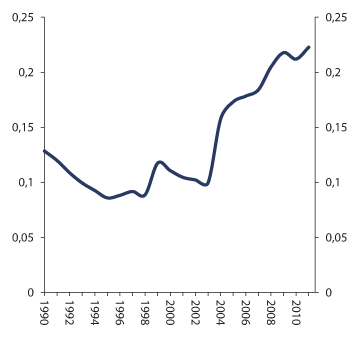
Figure 2.20 HHI developments, based on market shares as measured by total assets
Source Finanstilsynet.
Concentration in the Norwegian banking market is now relatively high compared to, inter alia, Denmark, Sweden, Ireland, the UK and Germany, when measured by the Herfindahl Index. Concentration is somewhat lower in Norway than in Finland, Belgium and the Netherlands. Like in Norway, the Herfindahl Index has increased since 2005 in both the Netherlands and Finland. In Sweden and Denmark, for example, the Herfindahl Index has, on the other hand, remained fairly stable over the same period, whilst it has declined significantly in Belgium.
2.8.1.2 Margins
The interest rate margin; the difference between the average lending rate of banks and the average deposit rate of banks, is a key source of income for banks, and must, together with other income, be sufficiently large to cover the costs and expected losses of banks. It can be assumed that interest rate margins are influenced by, but not only by, competition between banks. Cost developments, expected loss developments, as well as the distribution between margin income and other income may also be important.
Risk premiums in the market may also influence margins. If risk premiums in the market increase, return on equity requirements applicable to banks may for example increase in line with the market as whole. One should therefore bear in mind, when interpreting the interest rate margin for recent years in Figure 2.21, that risk premiums for banks during the period prior to the outbreak of the international financial crisis were very low, and that premiums have declined significantly from their highest levels, whilst still remaining much higher than the levels registered prior to the outbreak of the international financial crisis.
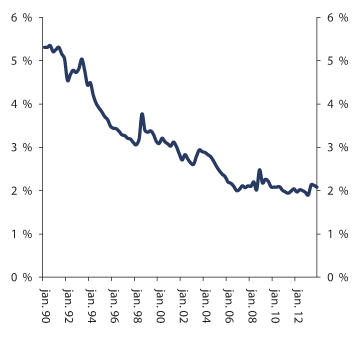
Figure 2.21 Interest rate margin developments for Norwegian banks. Percent
Source Finanstilsynet.
Figure 2.22A shows that the interest rate margin of banks has declined from just over 5.5 pct. to about 2 pct. since 1990. The interest rate margin has remained fairly steady at about 2 pct. from late 2006 until now, subject to some fluctuation at the time of the turbulence during the financial crisis in 2008.
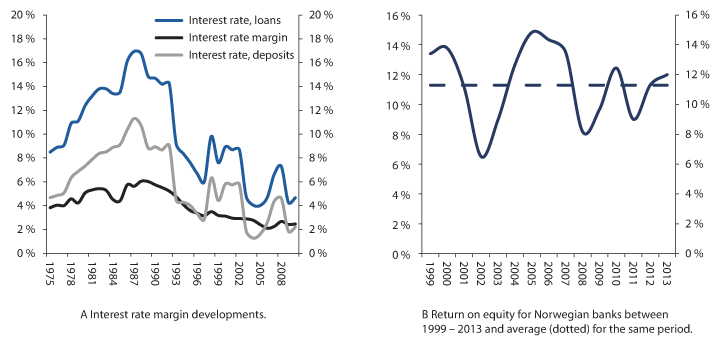
Figure 2.22 Interest rate margin (A) and return on equity developments (B) for Norwegian banks
Source Statistics Norway and the Norwegian Banks’ Guarantee Fund.
Returns on equity in excess of normal levels, in aggregate or within various market segments, may be yet another indication of limited competition.11 However, banking industry earnings are highly sensitive to cyclical fluctuations, and hence individual years of high or low earnings do not shed significant light on competition. If returns on equity in the banking industry are close to a normal equilibrium level over time, this may nonetheless indicate that the intensity of competition in the banking industry does not differ from that found in other industries.
Figure 2.22B indicates that the annual average return on equity over the period from 1999 to the 3rd quarter of 2013 fluctuated around a level of about 11.3 pct. The annualised return on equity at yearend 2013 was approximately 12 pct. This illustrates that the current return on equity is not unusually high compared to previous years. However, this comparison does not take account of the consideration that the return on equity requirement may be reduced as the equity ratio increases.
The return on equity of banks in the Norwegian market may be an indicator of competition between banks here and now, but may also have an important long-term impact on competition. If the return on equity is higher in Norway than in other banking markets, this may stimulate foreign banks to establish operations in Norway. If we look at profits before tax in proportion to total assets, the profitability of Norwegian banks is relatively high in an international context. The Nordic countries; Norway, Sweden and Finland, were characterised by high profitability, both before and during the crisis, compared to, inter alia, Germany, the Netherlands and Belgium. Admittedly, profitability in the US was somewhat higher before the financial crisis, but Norway, Sweden and Finland were the only countries in the sample addressed in a study by Ulltveit-Moe et.al with strictly positive earnings, in relation to total assets, throughout the financial crisis.12 In 2011, it was again only in the US that the profitability of banks, as measured in this way, was higher than in Norway.
In general, Nordic banks are also profitable in international terms when measured by returns on equity. From relatively similar levels in 1999, developments throughout the financial crisis have resulted in more pronounced inter-country variations in returns on equity in 2011. Whilst the UK and Denmark registered low bank profitability, Norwegian and Swedish banks delivered the highest returns on equity in 2011 in the sample of Ulltveit-Moe et.al.
2.8.1.3 Cost impact of regulatory changes
Banking regulations are currently undergoing change throughout the EEA. Regulatory changes may have an impact on the costs of banks. The degree of competition in the Norwegian market may be of considerable importance in determining the extent to which increased costs are passed on to customers, and the new regulations have triggered a competition debate in several countries.
It is hard to provide exact answers with regard to how a new regulation will influence the costs of Norwegian banks. Stricter capital requirements imply that banks need more equity per loan made than before. Generally speaking, equity is more expensive than debt.13 Consequently, stricter equity requirements may increase the total funding costs of banks. The overall effect on costs will depend on how much more expensive equity is than debt at the outset, and on how return on equity requirements and risk premiums change when banks get more equity and thus become more robust. The latter issue, in particular, has elicited considerable debate.
In the late 1950s, Franco Modigliani and Merton Miller developed a well-known theorem called the Modigliani-Miller Theorem.14 The theorem states that the value of a firm is, in equilibrium and under certain assumptions, unaffected by the ratio between equity and debt.15 The European Central Bank (ECB) has examined the extent to which the Modigliani-Miller Theorem actually holds true for banks.16 The ECB has used data for 54 banks from all over the world, including the large Nordic banks, for the period 1995–2011, and concluded that the Modigliani-Miller effect is likely to be in the region of 41 to 73 pct., depending on the specifics of the model. This would imply that between 41 and 73 pct. of the costs associated with a higher equity-to-assets ratio are recouped by way of a lower return on equity requirement. In addition, it would be reasonable to also expect the risk premium on debt to decline; cf. the above discussion. This further reduces overall funding costs, cf. the more detailed discussion of this issue in the Financial Markets Report 2011.
If we assume a difference of 10 percentage points between the return on equity and the interest rate on debt, and apply the above figures for the Modigliani-Miller effect, a 1 percentage-point increase in the CET1 capital ratio will increase funding costs by about 2 and 4 basis points.1718 Admittedly, these calculations are not definite. They are only intended to provide an indication of the potential effects of stricter capital requirements.
Residential mortgage guidelines may also have had an impact on interest rate margins. These guidelines imply that riskier customers do not obtain residential mortgages. Consequently, the lending portfolios of banks become less risky, which should contribute to both lowering residential mortgage funding costs and reducing the margins required on such mortgages.
Expectations of future regulatory changes may also have an impact on funding costs and lending margins. It is likely that this has been experienced during previous instances of extensive regulatory change. Expectations of a new system for the winding-up of banks that enter into liquidation may, for example, already now be affecting the prices of long-term bank funding and result in banks changing their margins. This is discussed in more detail in Chapter 3.2.5. A structured arrangement for the winding-up of banks may reduce the implicit support expectation on the part of large banks. The value of such support expectations may be high. The Norwegian Financial Crisis Commission assumed, for example, that DNB enjoyed an implicit government guarantee valued at between NOK 1 and 4 billion annually.19 Moreover, expectations of new liquidity and stable funding requirements may also have an impact on bank margins. This is discussed in more detail in Chapter 3.2.2. It is difficult to quantify the overall effect of financial markets regulations and the expectations of banks and investors in relation to these.
More formalised models have been developed to link the degree of competition to corporate income. The Panzar-Rosse H-statistic is a frequently used model. It illustrates the income of a bank upon a change in the price of the factors of production. The thinking behind the model is that banks engaged in perfect competition will in the long run have to get their average costs covered, but no more. Higher values of the H-statistic are associated with more competition, and in a perfect competition scenario the H-statistic will be equal to 1, which represents a full cost impact. The Federal Reserve Bank of St. Louis has estimated the H-statistic for the Norwegian banking market based on data from the World Bank for 2010 and arrived at a figure of 0.3. This is fairly low and indicates, when taken in isolation, that competition amongst Norwegian banks is low.
The Panzar-Rosse H-statistic has a theoretical underpinning and may therefore offer advantages in comparison with analyses seeking to shed light on competition via structural measures such as, for example, concentration, or by the observation of profits and margins. However, it is not always the case that the assumptions on which the Panzar-Rosse statistic is premised are met in practice.
2.8.2 The retail customer market
If customers do not switch from expensive banks to cheaper banks, the competition between banks becomes ineffective. Low customer mobility may result from lock-in programmes, i.e. that a bank offers a combination of salary account, insurance and loans, or from prices being difficult to compare, or from other circumstances that customers perceive as barriers to switching.
Figure 2.23 shows developments in various factors that shed light on the loyalty of Norwegian retail customers. The percentage of retail customers that did not switch or make use of a new bank over the last 12 months has remained stable at 88 for the last decade. More than 40 pct. participate in some form of customer programme offered by the bank, and this portion has increased gradually from about 28 pct. in 2004. In 2013, five percent of customers had switched their main bank over the last 12 months, whilst 6 pct. started to make use of a new bank, in most cases an additional bank. The same survey shows that only 7 pct. have ever checked the Finansportalen financial service comparison website.
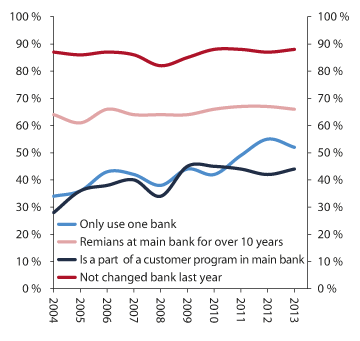
Figure 2.23 Switching between banks in the retail customer market. Percent
Source Finance Norway.
Other data may nuance this. The Norwegian Consumer Council’s switching survey for 2013 shows that one third of retail customers have renegotiated their residential mortgages or switched residential mortgage banks in the last two years. This may be an indication that consumers are price conscious and use market information to improve the terms offered by the banks of which they are already customers, but without switching banks. Such developments may have been boosted by technological progress within the industry and price comparison tools like Finansportalen.
Figure 2.24 shows concentration as measured by HHI for deposits from retail customers and residential mortgages to retail customers. These measures provide a better illustration of concentration in the retail customer market than the data presented in the introduction, which cover the market as whole. The figure shows that concentration in accepting deposits from, and lending to, retail customers is lower than for banks as a whole, and that concentration has declined in recent years. The upward shifts in concentration have to do with the merger between Postbanken BA and Den norske Bank ASA in 1999 and the merger between DNB NOR ASA and Gjensidige NOR Sparebank ASA in 2003.
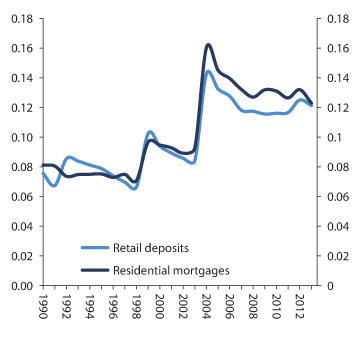
Figure 2.24 HHI for deposits from retail customers and residential mortgages
Source Finanstilsynet.
The interest rate margin of banks does not reflect the fact that accepting deposits and granting loans are different activities. The lending margin of banks is the margin between the lending rate of banks and the money market rate. NIBOR is frequently used as a measure of the money market rate. NIBOR is a benchmark rate, and a very considerable number of financial market contractual relationships are linked to such rate. Figure 2.25 shows that there was a leap in the margin on lending to retail customers upon the outbreak of the financial crisis. As at yearend 2013, the lending margin in relation to private sector businesses and retail customers was the same, as measured by the NIBOR differential. This indicates higher profitability and less competition in the retail customer market than in the market for private sector businesses, since margins for private sector businesses are generally associated with higher risk.
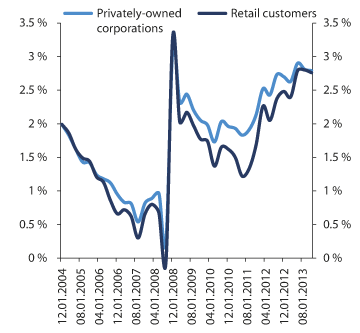
Figure 2.25 Difference between lending rates on various loan types and 3-month NIBOR. Percent
Source Finanstilsynet.
NIBOR is an important benchmark rate in the derivatives market and for determining the lending rates of banks, although the lending margin as measured by NIBOR does not precisely express the lending margins of banks, because their costs of funding a loan may deviate from NIBOR. Norges Bank has therefore estimated the funding costs of banks for residential mortgages from 2010 until yearend 2013, as calculated on the basis of the weighted interest rate on the covered bond loan holdings and the weighted deposit rate. Figure 2.26 below shows that the lending margin on residential mortgages has, based on these data, increased significantly since 2012. At yearend 2013, the lending margin, defined as the interest rate on new residential mortgages less the estimated funding cost, was approximately 1.8 pct., an increase from about 0.5 pct. in August 2011. Besides, estimated funding costs have not declined in the same way as money market rates in recent years. Consequently, Figure 2.26 may indicate that competition between banks has weakened over the last couple of years as far as lending to retail customers is concerned. On the other hand, it is not evident that the lending margins from the autumn of 2011 were sufficiently high to cover the costs and risks of banks in relation to such lending.
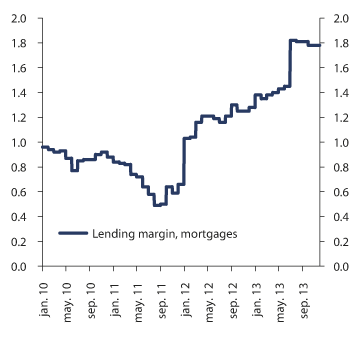
Figure 2.26 Residential mortgage lending margins based on average residential mortgage interest rates and estimated residential mortgage funding costs. Percentage points
Source Norges Bank.
2.8.3 The corporate market
Loans to corporations are less homogeneous than residential mortgages for retail customers. Loans to corporations are more diversified and, on average, associated with more risk, and banks often need to have detailed knowledge of the outlook for the industries in which corporations are engaged.
The funding costs of banks are not closely linked to NIBOR as far as lending to corporations is concerned either. As with the retail customer market, Norges Bank has estimated a funding cost that is assumed to better reflect the actual funding cost. The funding cost for lending to corporations is estimated on the basis of the weighted interest rate on the senior bank bond holdings and the weighted deposit rate.
Figure 2.27 illustrates the lending margin in relation to corporations, based on the lending rate for corporate loans less the estimated funding cost for corporate loans. The figure shows that the lending margin for private businesses has remained relatively stable in recent years. The estimated funding cost for corporate loans has not declined to the same extent as the money market rate since 2012. The lending margin in relation to corporations has remained stable at about 2 pct. in recent years, and was 2 pct. at yearend 2013. Corporate loans are associated with more risk, and hence one would expect the lending margin to be higher if competition was the same as in the retail customer.
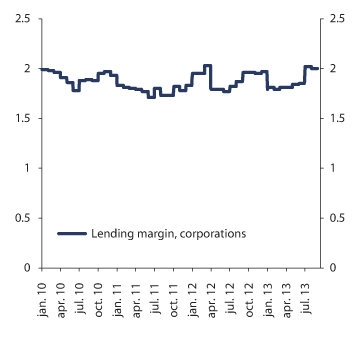
Figure 2.27 Corporate lending margins based on corporate lending rates and estimated corporate loan funding costs. Percentage points
Source Finanstilsynet.
Footnotes
Karen Helene Ulltveit-Moe, Bent Vale, Morten H. Grindaker and Erling Skancke (2013), Competitiveness and regulation of Norwegian Banks. Norges Bank Staff Memo 18/2013.
Modigliani, F. and Miller, M. (1958), The cost of capital, corporation finance and the theory of investment, American Economic Review 48(3): 261–297.
These assumptions are unlikely to apply in full because, inter alia, tax implications and informational asymmetries may make it more expensive to obtain funding in the form of new share capital than in the form of debt.
European Central Bank (2011), Common equity capital, banks’ riskiness and required return on equity, Financial Stability Review December 2011.